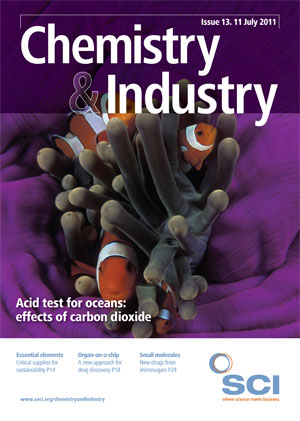Formaldehyde is back under the spotlight in the US; this time as one of eight substances that have been added to the 12th Report on Carcinogens (RoC), compiled by the US National Toxicity Program (NTP) on behalf of the Department of Health & Human Services (HHS). This science-based document identifies chemicals and biological agents that may put people at an increased risk for cancer. The other substances added to the report included styrene, o-nitrotoluene, captafol, cobalt–tungsten carbide, in powder or hard metal form, riddelliine, certain inhalable glass wool fibres and botanicals known as aristolochic acids.
The president and ceo of the American Chemistry Council, Cal Dooley, responded to the inclusion of formaldehyde saying: ‘We are extremely disappointed that HHS has moved forward with listing formaldehyde in its 12th RoC as a “known carcinogen”’. He accused the HHS of ignoring the recent independent, peer-reviewed report from the US National Research Council, which strongly questioned whether scientific evidence supports the claim of formaldehyde being a human carcinogen for leukaemia. He also noted that the World Health Organization indicates that normal human exposures do not present a risk.
‘Inclusion in the RoC does not mean that formaldehyde presents any risk to human health. In fact, NTP itself states… Listing in the report does not establish that such substances present a risk to persons in their daily lives,’ Dooley added.
The Styrene Information & Research Center (SIRC) also responded, saying that the inclusion of styrene is ‘unwarranted’. SIRC executive director Jack Snyder said: ‘The US styrene industry will contest vigorously the HHS’s listing… because the designation is completely unjustified by the latest science and resulted from a flawed process that focuses only on those data that support a cancer concern and, in the case of styrene, ignored the preponderance of data that fail to suggest a cancer concern for this substance.
‘HHS included styrene… despite the fact that EU regulators have determined that styrene does not represent a human cancer concern,’ added Snyder.
Also in the US, the Environmental Protection Agency (EPA) has made public the identities of over 150 chemicals contained in 104 health and safety studies that had been claimed confidential by the chemical industry, in a move designed to provide greater access to information on chemicals that are manufactured and used in the US. The substances involved are used in dispersant formulations and consumer products, such as air fresheners, nonstick and stain- and fire- resistant materials, and include nonylphenol compounds, perfluorinated compounds and lead.
The EPA has also recently provided public access, for the first time, to the consolidated Toxic Substances Control Act Inventory through its own and Data.Gov websites. It has also launched a new chemical data access tool that allows people to search electronically the EPA’s database of over 10,000 health and safety documents on a wide range of chemicals.
Meanwhile the European Chemicals Agency (ECHA) has added seven more substances to the Candidate List of Substances of Very High Concern (SVHC) for authorisation. The additions include 2-ethoxyethyl acetate; strontium chromate; 1,3- benzenedicarboxylic acid, di-C7- 11-branched and linear alkyl esters; hydrazine; 1-methyl-2-pyrrolidone; 1,2,3-trichloropropane; 1,2- benzenedicarboxylic acid, di-C6-8 branched alkyl esters, C7-rich (DIHP); and cobalt dichloride, bringing to 53 the total number of substances on the SVHC list.





